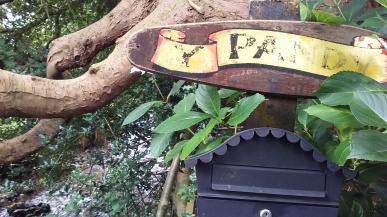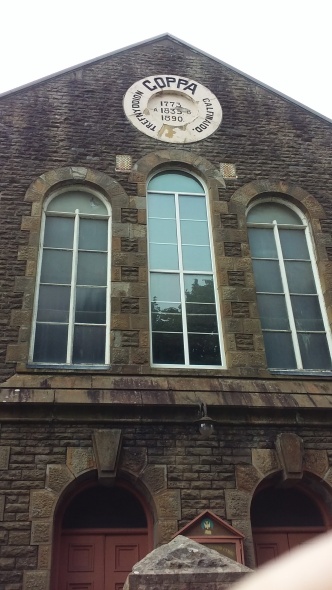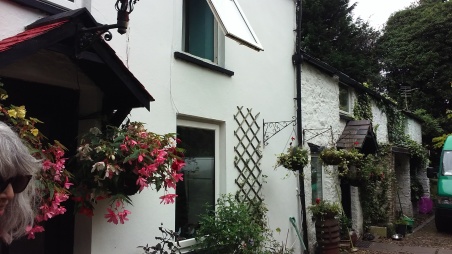 Wed. May 25th [1892] ….After tea we took a walk to the coal pit from which place we could see the Pandy & Alltiago farm. We got a glass of fresh milk at the Alltiago farm….Continuing our walk we went to see Mrs. Johns (Nancy Willsaer) who used to work for my grandparents.
Wed. May 25th [1892] ….After tea we took a walk to the coal pit from which place we could see the Pandy & Alltiago farm. We got a glass of fresh milk at the Alltiago farm….Continuing our walk we went to see Mrs. Johns (Nancy Willsaer) who used to work for my grandparents.
When I read, in my great-grandmother Mary Davies’ diary, that she saw “the Pandy,” I assumed she was referring to a river. At the age of 20, the girl who had grown up in Topeka, Kansas, was visiting her father’s relatives in Wales, in the town of Pontardulais. I went there this summer to see what she had seen 124 years ago.
I was also researching the family of her father, William Davies, who had emigrated from Pontardulais to Ohio with his family. I had the name of his father, Morgan, from a cemetery record, and the names of four siblings—Mary, Sarah (nicknamed Sally), Daniel, Jane–from letters, and not much else to go on, except hints in the diary, which proved to be vital.
At the West Glamorgan archives in Swansea, I found Llandeilo Talybont Parish baptism records for four children of Morgan and Mary Davies—William, Sarah, Daniel, and Jane. Morgan’s address was given as “Pandy,” his occupation as “Tucker.” The Internet revealed that a tucker is someone who processes wool, cleansing the fabric of oils and pounding it so the fibers interlock for strength and waterproofing. But I couldn’t find a town (or a river) called Pandy. And Davies is such a common surname, I couldn’t be sure I had the right family.
 Mary’s diary led me to Goppa Road, on the outskirts of Pontardulais, where she attended services one Sunday at the Calvinistic Methodist chapel. It was two miles from where she was staying, but by then, two months into her visit, she didn’t blink at walking that far.
Mary’s diary led me to Goppa Road, on the outskirts of Pontardulais, where she attended services one Sunday at the Calvinistic Methodist chapel. It was two miles from where she was staying, but by then, two months into her visit, she didn’t blink at walking that far.
At half past nine we started for Goppa Chapel for the morning service. After the service we went to Nancy Willsaer’s for dinner. She had “cawl” [broth] for dinner. After dinner she got the key & we went in the Goppa-fach. She showed us just where Aunt Sally & she used to sit, & told us how the boys would sit behind them & tease them.
“Aunt Sally” had to be William’s sister, so his family had attended Goppa Chapel—which is still in operation, although it’s now Presbyterian. I went to the Sunday service, given in Welsh. My friend Kristin and I were greeted by a chapel elder, Eifion Davies (not my relative, as far as we know), who offered to help me with my genealogical research. Several women of the congregation heard my story and told me about the pandy, which was not a town, district, or river but a wool-processing mill—and it was located less than a mile away. Surely this Morgan Davies and his family attended Goppa Chapel!
After the service, Eifion showed us the pandy, situated on the River Dulais, which furnished power for the mill. The building is now a residence, and the woman who has lived there for the past 40 years brought out a scrapbook of historical documents. The first pandy on the site was built in 1448. It was replaced twice, the last time being in about 1750. The mill wheel drove hammers that pounded the wool. People wove their own cloth and then brought their woolen goods to the mill for processing. Surely such a business would require an employee or two–such as Nancy Willsaer.
 Two known names and an appropriate date–as represented by the 1830 baptism record of William, son of Morgan Davies—are not sufficient to establish a family relationship. But adding up the further coincidences—the names of three known siblings and the proximity to a chapel where at least one family member was reported to attend—I’m now pretty sure Morgan Davies the tucker was my great-great-great-grandfather.
Two known names and an appropriate date–as represented by the 1830 baptism record of William, son of Morgan Davies—are not sufficient to establish a family relationship. But adding up the further coincidences—the names of three known siblings and the proximity to a chapel where at least one family member was reported to attend—I’m now pretty sure Morgan Davies the tucker was my great-great-great-grandfather.
I am grateful to Mary for the diary and to the people of Goppa Chapel for preserving the knowledge that led me to Morgan and his pandy.

Interesting why some of us really need to know what kind of dirt we came from.
In my case, it’s partly because my ancestors left so much tantalizing material–I’m compelled to try to fill in the gaps. I feel they want this research from me, and I like the feeling of connection it gives me. Once you start, it’s hard to stop–